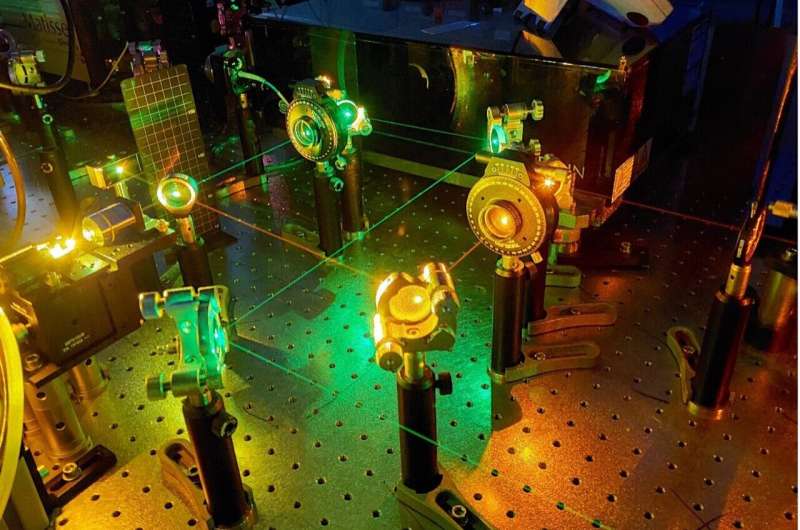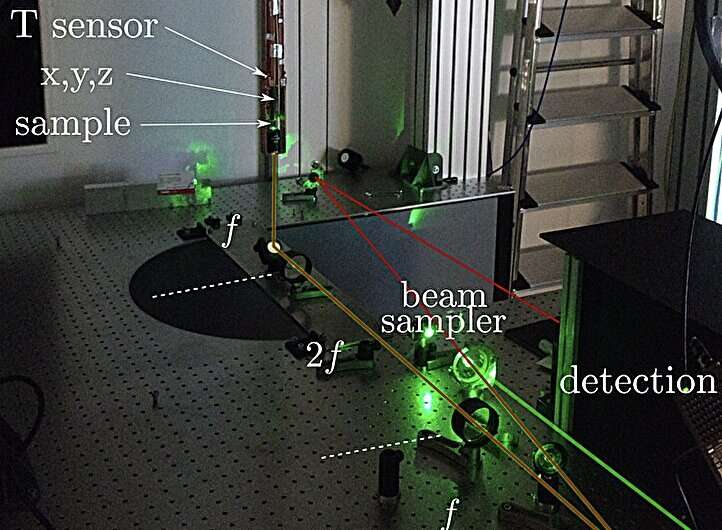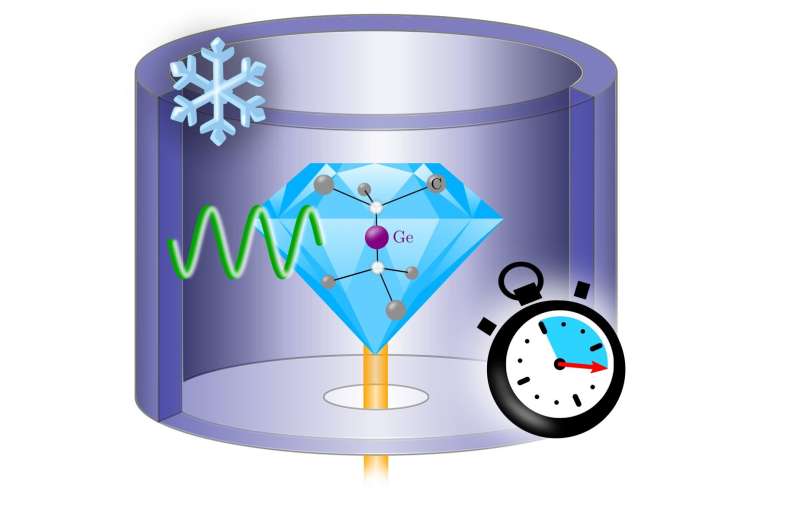February 16, 2024 feature
This article has been reviewed according to Science X's editorial process and policies. Editors have highlighted the following attributes while ensuring the content's credibility:
fact-checked
peer-reviewed publication
trusted source
proofread
Diamond quantum memory with Germanium vacancy exceeds coherence time of 20 ms

The color centers of diamond are the focus of an increasing number of research studies, due to their potential for developing quantum technologies. Some works have particularly explored the use of negatively-charged group-IV diamond defects, which exhibit an efficient spin-photon interface, as the nodes of quantum networks.
Researchers at Ulm University in Germany recently leveraged a Germanium vacancy (GeV) center in diamond to realize a quantum memory. The resulting quantum memory, presented in a Physical Review Letters paper, was found to exhibit a promising coherence time of more than 20 ms.
"Our research group's primary focus is the exploration of diamond color centers for quantum applications," Katharina Senkalla, co-author of the paper, told Phys.org. "The most popular defect of diamond so far has been the nitrogen-vacancy center, but, recently, other color centers have also become a focus of research. These consist of an element from the IV column of the periodic table—Si, Ge, Sn or Pb, and a lattice vacancy (i.e., missing next-neighbor carbon atom)."
Group-IV color centers have been found to exhibit far stronger emissions in the zero-phonon line than previously employed nitrogen-vacancy centers. In addition, these centers' inversion symmetry makes them well suited for integration in nanophotonic devices—an important step for an efficient scalable quantum network based on solid-state, single-photon sources.
"Our aim is to make significant contributions to the development of quantum networks that facilitate long-distance quantum communication and distributed quantum computing," Senkalla said. "In the realm of quantum networking, a crucial aspect is the quantum network node, which demands an efficient spin-photon interface and extended memory times."
The research group at Ulm University has been exploring the potential of group IV defects as candidates for quantum network nodes for some time now, recently focusing on the GeV center. These particular defects have an inherent efficiency in the spin-photon interface, which is characterized by a highly coherent flux of photons.
Such a coherent flux of photons is a crucial element for enabling effective quantum communication over long distances. Nonetheless, realizing quantum systems using group IV diamond defects entails overcoming various challenges.
"These defects encounter obstacles related to extended memory times due to phonon-mediated relaxation, impacting coherence and memory time," Senkalla explained. "Our recent work is focused on addressing this pivotal challenge, driving forward the development of robust quantum network nodes. Through our endeavors, we aspire to overcome these obstacles and contribute significantly to the advancement of quantum technologies."

The system developed by Senkalla and her colleagues utilizes a GeV as the quantum memory element. To overcome the challenges commonly associated with the development group IV defect-based quantum systems, the researchers employed a two-fold strategy.
The first part of this strategy is aimed at mitigating the adverse impact of phonons on quantum information. In fact, group IV defects can easily couple with phonons, which can destroy quantum information.
"To overcome this challenge, we utilized a Dilution Refrigerator (DR), a sophisticated device widely in use for sophisticated quantum computing experiments e.g. in IBM's quantum computing experiments. It can prepare temperatures in the few hundred millikelvin range," Senkalla said.
"The second part of our approach, on the other hand, tackles the decoupling from spin noise and optimization of information storage. Operating at such a low temperature range revealed spin noise as the primary factor in decoherence. To prolong memory times and shield quantum information, we implemented meticulous spin refocusing with microwave pulses and at strategically chosen time intervals in which computational operations can be performed."
A further aspect that Senkalla and her colleagues had to consider when developing their quantum memory was the management of the heat load introduced with every control pulse. In fact, dilution refrigerators have a limited cooling capacity, and exceeding this limited capacity could elevate the temperature and thus facilitate the generation of phonons, which could in turn lead to decoherence.
"Developing an optimized pulse sequence involved employing the Ornstein-Uhlenbeck process, a noise modeling technique capturing the system's dynamics," Senkalla said.
"The Ornstein-Uhlenbeck simulations provided important insights into noise dynamics, enabling the finding of sequences that delicately balanced spin refocusing, computational intervals and the management of experimental heat load."
The researchers tested their proposed quantum memory in both experiments and simulations. Notably, the results they achieved in simulations were closely aligned with the experimental data.
"Ours is the first successful demonstration of efficient spin control for the germanium vacancy (GeV) at millikelvin temperatures," Senkalla said. "The comprehensive methodology we introduced, with relevance beyond GeV, holds potential for advancing quantum memory performance across diverse experimental conditions and other group IV defects."

The design underpinning the researchers' proposed quantum memory is relatively simple and could be replicated using other group IV defects beyond GeVs. This design was ultimately found to extend the coherence times of GeV-based memories by a factor of up to 45, reaching a record coherence time of 20 milliseconds.
The remarkable findings presented in the paper highlight the potential of GeV defects for developing quantum network-based systems. In the future, this work could inspire the greater use of group-IV defects for quantum communication applications.
"Our study extends beyond the lab, offering valuable insights into the practical applications of GeV and other group-IV defects in quantum technologies," Senkalla said.
"Our Ornstein-Uhlenbeck simulations pave the way to optimized control schemes for GeV and similar defects under various experimental conditions. The potential impact extends to industries like Amazon Web Services (AWS), exploring quantum networks based on group IV defects like SiV."
The recent study by Senkalla and her colleagues could eventually contribute to the advancement of quantum communication systems, as well as various industries that may benefit from highly performing quantum technologies. Meanwhile, the researchers plan to continue exploring the potential of GeV diamond defects as quantum network nodes.
"Expanding on our exploration of the GeV and its potential as a quantum network node, we are actively incorporating GeV into an actual quantum network," Senkalla said.
"Our team in Ulm is in the process of constructing experimental setups to serve as additional nodes in this quantum network, aligning with our vision for Ulm to become the demonstrator location for a quantum network centered on group IV defects in Germany."
In their upcoming studies, the researchers plan to incorporate GeVs into nanophotonic cavities, while also addressing surrounding nuclear spins. These two steps are both crucial for the upscaling of quantum networks.
"The first of these steps enhances our photon rate and thus the entanglement rate and the latter enables the implementation of quantum error correction protocols, an important step toward achieving fault-tolerant quantum computing," Senkalla added.
"We are on an exciting journey and looking forward to push our research further."
More information: Katharina Senkalla et al, Germanium Vacancy in Diamond Quantum Memory Exceeding 20 ms, Physical Review Letters (2024). DOI: 10.1103/PhysRevLett.132.026901. On arXiv: DOI: 10.48550/arxiv.2308.09666
Journal information: Physical Review Letters , arXiv
© 2024 Science X Network




















